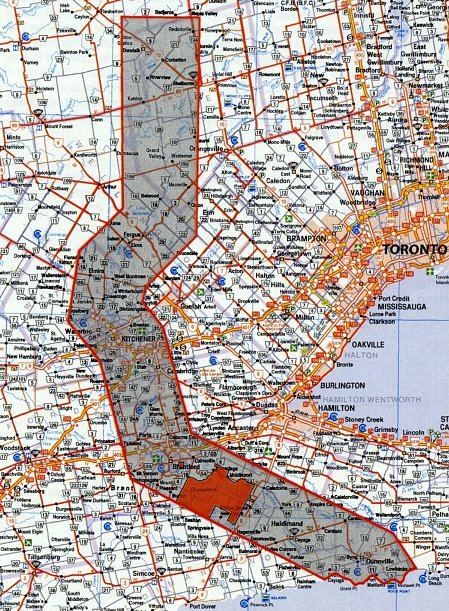 Six Nations, southwest of Hamilton Ontario, is the largest reserve in Canada, with 27,000 members, though only 12,000 live on the reserve. It is a mini-multicultural nation, the only reserve in North America that has all six Iroquois nations living together.
Six Nations, southwest of Hamilton Ontario, is the largest reserve in Canada, with 27,000 members, though only 12,000 live on the reserve. It is a mini-multicultural nation, the only reserve in North America that has all six Iroquois nations living together.The Haldimand Proclamation, negotiated by Joseph Brant on behalf of the Six Nations in 1784 in gratitude for native support of Britain against the American revolutionaries, was, until 1924, governed by the traditional native government, now called the Haudenosaunee Confederacy Chiefs Council (HCCC). It promised the lands "six miles deep from each side of the river beginning at Lake Erie and extending in that proportion to the head of the said river which them and their posterity are to enjoy forever."
This agreement was a decree, never formalized as a treaty,
promising what translated into 950,000 acres of what is arguably Canada's most fertile, scenic, and resource-rich land. As this became apparent in the 19th century, the decree was downgraded by the government, using a new survey in 1821, to 674,910 acres. Canada prides itself in 'winning' the war of 1812, but despite fighting for the British then, the result for the natives was to have their earlier promises betrayed, in the first place via the theft of 90% of the land promised to the Six Nations. Canada was becoming 'independent', but for the settlers only.
Ignoring the proclamation, settlers moved into Six Nations territory, the land was cleared and became unsuitable for hunting. Only a small section, now the Six Nations reserve, was left, though it too was mostly denuded and is now primarily used to grow tobacco. The Six Nations were forced to surrender lands to the Crown purportedly to raise funds for the perpetual care and maintenance of Six Nations. Soon, the Crown had expropriated approximately 600,000 acres in questionable transfers. The Crown appointed “Indian Agents” which gave Six Nations’ land to friends and families, or sold land in order to pay their own salaries. Forty years after the Haldimand Treaty was confirmed, Six Nations were dispossessed of 90% of their original grant.
In 1924, the Canadian government dissolved the native governing structures completely, and installed the elected council system according to the 1876 Indian Act, in the case of the Haudenosaunee, the Six Nations Elected Band Council (SNEBC). This divided the natives, who were forced to accept the changes, resulting in a schism in the community with those who held on to traditional governing structures, embodied in the Great Law of Peace, that exists to this day.
From approximately 1840 to 1865, the Six Nations Confederacy council met in a log building near Middleport (since, confiscated). In 1856, against protests from the Onondaga chiefs, Indian Department superintendent Jasper Gilkison established a council building in what is present day Ohsweken, about 6 km south-west of Middleport.
From approximately 1840 to 1865, the Six Nations Confederacy council met in a log building near Middleport (since, confiscated). In 1856, against protests from the Onondaga chiefs, Indian Department superintendent Jasper Gilkison established a council building in what is present day Ohsweken, about 6 km south-west of Middleport.
The traditionals have no government recognition or funding, weakening their ability to function effectively. But at moments of crisis, the two power structures have worked together, however hesitantly. The elected council for the Six Nations, the SNEBC, is run like a western-style local government, and is headed by Chief Ava Hill. The Haudenosaunee Confederacy is governed more diffusely, incorporating traditional roles of each of the member tribes. There are 50 chief positions, though not all are filled.
But for the Great Law to function, at least half of all the members must actively support the traditional ways (really it should be unanimous). That is the bottom line, according to native rights activist Nicole Lebrasseur, who is working through the Canadian People's Union to popularize the Great Law as a prototype for all Canadians, as a way to fight neoliberalism and corporate globalization, where corporations continue to erode citizen democracy. "The Six Nations can be the germ of a renewal of genuine democracy for all nations," says Nicole Lebrasseur.
Current stand-off
The current Grand River land dispute hit the mainstream media in 2006 when the Six Nations formally reactivated their 1995 suit against Canada and Ontario, protesting to raise awareness about their land claims, in particular, 40 hectares in the Haldimand Tract in Caledonia, Haldimand County. Henco Industries Ltd had purchased in 1992, and planned to develop it as the upscale Douglas Creek Estates.
When the contested land was officially registered for real estate development in 2005, this led the traditionals, the HCCC, to stage protests, closing roads, and at times escalating to damage of electricity generation and even the burning of a bridge. While not condoning the actions, the elected band council benefited from them, the national publicity they generated, creating the conditions which pushed the federal and provincial governments into action to solve the dispute. Call it: the elected council natives playing the good cop to the traditionalist bad cop.
In May 2006, natives occupied Douglas Creek Estates and twenty-one were arrested, prompting several hundred natives, some of whom were masked and were armed with baseball bats, axes and hockey sticks, to return to the site. The police retreated and the natives reclaimed the site and set up roadblocks along the access street. During the evening, the protesters put hundreds of tires across the highway, doused them with gasoline and lit them.
“As the world has seen, our protest has been firm but peaceful. Our people are responding without weapons, using only their bodies to assert that we are a sovereign people with a long history and that we cannot be intimidated,” said Six Nations Confederacy Chief Allen McNaughton. When the community's chiefs ask people to abandon the barricades, it was the clan mothers who overrule them, leading a cultural reawakening in their traditionally matriarchal community.
Local nonnatives were furious and in June more than 400 area residents and businesses filed a class-action suit against the Ontario provincial government for its failure to protect them adequately. This was settled in July 2011, with the government paying the nonnatives $20 million and prosecuting several demonstrators.
In 2007, another development site within six miles of the Grand River in nearby Brantford was blocked off by protesters. On September 13, Sam Gualtieri, a builder, was attacked in a confrontation with occupiers at the 90-home Stirling Woods development and seriously injured. Mohawk native Richard Smoke was convicted of assault for resisting Gualtieri when he tried to force Smoke and several others to leave his daughter's house, which he was helping build as a wedding present. Smoke later apologized to Gualtieri in court.
The 2006 government promise read, "It is the intention that the land title be returned to its original state, its status under the Haldimand Proclamation.” The historic road-block stand-off over Caledonia and the Burtch Lands ended in 2010 with the province promising to hand it back the Haudenosaunee Confederacy, but instead putting it in a federal corporation, with an Six Nations Elected Council member on the board.
Elected Council vs Confederacy
The stand-off in Caledonia continues, pitting the SNEBC against the traditional Confederacy. In 2010, the SNEBC rescinded a motion that recognized the Haudenosaunee Confederacy Council as the leader for the Douglas Creek Estates site in Caledonia. “The Confederacy negotiating team has been there for four years with limited success,” said SNEBC rep Chief William Montour. At the same time, Mohawk farmer Kristine Hill, who had been farming a section of the nearby Burtch Lands (formerly seized by the Ontario government and used as a prison) under authorization of the Haudenosaunee Confederacy, was evicted after an injunction was filed against her by the government on behalf of the SNEBC, the elected council. A decision on this case, along with a contempt of court charge, was delivered in an Ontario court in September 2017.
“We the Onkwehonwe of Kanonhstaton are still standing strong,” said Ronda Martin, in front of the blockade decorated with Haudenosaunee and Mohawk Warrior flags, built of what appeared to be part of a decommissioned electrical tower. “We ask again for the public’s patience as we work on some very complicated issues.” In a YouTube video uploaded by Turtle Island News on August 17, Doreen Silversmith listed off three demands of Six Nations people at the barricade. They include that the province and the Canadian government return to the negotiation table with the Confederacy, that Ontario honour its promise to really return the land, and that Six Nations elected band council withdraw its injunction against Hill. This latest blockade ended peacefully in early September, but after the court ruling upholding the eviction, the matter remains unsettled.
The confederacy is refusing to acknowledge the Ontario government corporation, which would still leave Canadian officials in control through the elected council. Ontario Premier Wynne threw the gauntlet, playing games with the band, in an attempt to undermine the authority of the HCCC, by utilizing the factions the government has created to get what they want: the complete and total assimilation of the Six Nations.
There are 28 land claims by Six Nations, which have been on the books since the 1990s when litigation against the federal government was filed. This, as well as other court challenges made through the Elected Council since then, have all stalled without ever being heard and without the SNEBC being able to achieve any headway.
This stand-off reached a crisis point in the 1959 occupation of the elected council meeting in the Old Council House, which lasted 8 days, with the demand to disband the band council and reinstate the confederacy. The elected council chief resigned, but the 'revolution' was still born.
Part III Prospects for Metis civilization





